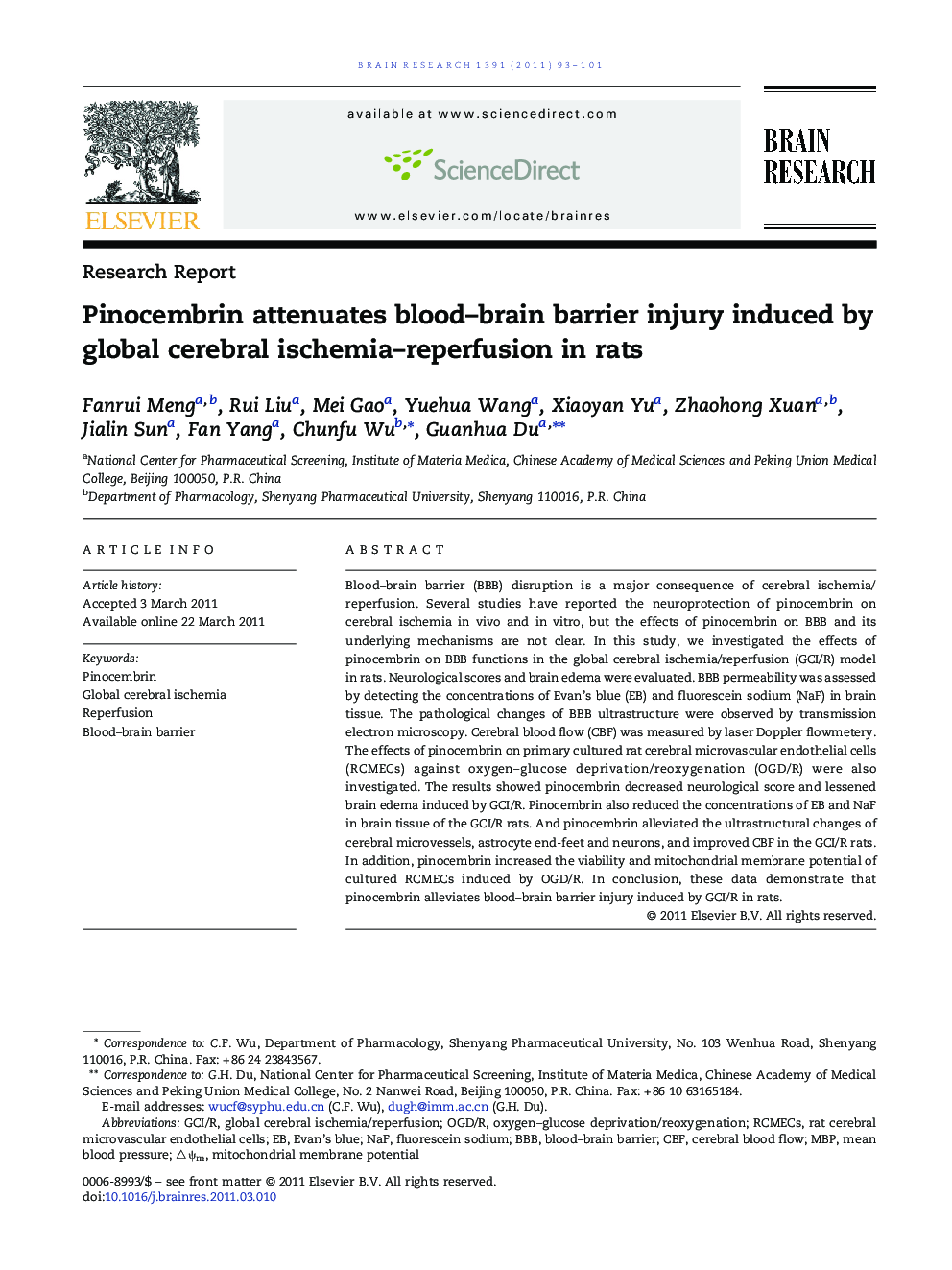| کد مقاله | کد نشریه | سال انتشار | مقاله انگلیسی | نسخه تمام متن |
|---|---|---|---|---|
| 4325951 | 1614048 | 2011 | 9 صفحه PDF | دانلود رایگان |

Blood–brain barrier (BBB) disruption is a major consequence of cerebral ischemia/reperfusion. Several studies have reported the neuroprotection of pinocembrin on cerebral ischemia in vivo and in vitro, but the effects of pinocembrin on BBB and its underlying mechanisms are not clear. In this study, we investigated the effects of pinocembrin on BBB functions in the global cerebral ischemia/reperfusion (GCI/R) model in rats. Neurological scores and brain edema were evaluated. BBB permeability was assessed by detecting the concentrations of Evan's blue (EB) and fluorescein sodium (NaF) in brain tissue. The pathological changes of BBB ultrastructure were observed by transmission electron microscopy. Cerebral blood flow (CBF) was measured by laser Doppler flowmetery. The effects of pinocembrin on primary cultured rat cerebral microvascular endothelial cells (RCMECs) against oxygen–glucose deprivation/reoxygenation (OGD/R) were also investigated. The results showed pinocembrin decreased neurological score and lessened brain edema induced by GCI/R. Pinocembrin also reduced the concentrations of EB and NaF in brain tissue of the GCI/R rats. And pinocembrin alleviated the ultrastructural changes of cerebral microvessels, astrocyte end-feet and neurons, and improved CBF in the GCI/R rats. In addition, pinocembrin increased the viability and mitochondrial membrane potential of cultured RCMECs induced by OGD/R. In conclusion, these data demonstrate that pinocembrin alleviates blood–brain barrier injury induced by GCI/R in rats.
1. (1) Pinocembrin alleviated the pathological changes of ultrastructure in microvessels, neurons and glial cells in the global cerebral ischemia/reperfusion (GCI/R) rats. Representative electron photomicrographs were shown. A, B and C showed the microvessels in parietal cortex, × 2.0 k. A, sham group, with normal microvascular endothelial cells, basal lamina (a) and astrocyte end-feet (b). B, GCI/R group, microvascular lumina was crushed and became narrow (c), end-feet of astrocyte were serous edema (d), and the membrane of end-foot was disrupted (e). C, pinocembrin 5 mg/kg group, the edema of end-feet were mitigated (f). D, E and F showed the neurons in parietal cortex, × 0.7 k. D, sham group; E, GCI/R group, nucleolus condensed and electron density of the neuron increased; F, pinocembrin 5 mg/kg group, the injury was lessened. G, H and I showed the glial cells in parietal cortex, G × 1.0 k, H × 0.7 k, I × 1.2 k. G, sham group; H, GCI/R group, the glial cell was serous edema (g); I, pinocembrin 5 mg/kg group, the edema of glial cell was lessened (h). (2) Pinocembrin alleviated the edema of astrocyte endfeet in the GCI/R rats. #P < 0.05 vs. sham group, *P < 0.05 vs. GCI/R group, n = 4.Figure optionsDownload high-quality image (198 K)Download as PowerPoint slideResearch highlights
► Pinocembrin protected BBB in the global cerebral ischemia/reperfusion rats.
► Pinocembrin reduced the permeability of BBB.
► Pinocembrin mitigated ultrastructural changes of neurovascular unit.
► Pinocembrin improved cerebral blood flow.
► Pinocembrin protected rat cerebral microvascular endothelial cells against OGD/R.
Journal: Brain Research - Volume 1391, 19 May 2011, Pages 93–101